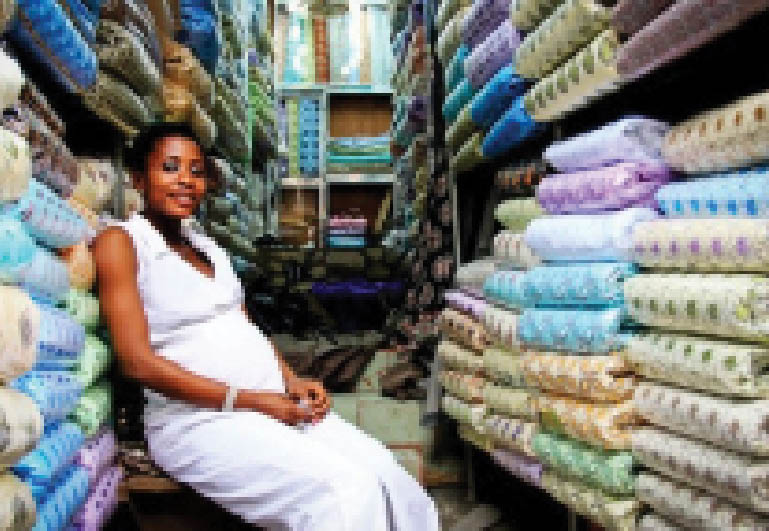In Idumota, Lagos Island, Kadmos Fabrics is a big dealer of clothing materials, especially lace. Kadmos has quite a spacious shop on Nnamdi Azikiwe Street and another one on John Street.
The indubitable success of this shop, which occupies a tall building of three floors, with the inscription ‘Kadmos House’ boldly written on it, signposts the fortune that lace merchandise has become on Lagos Island. Flung across the Island, from Idumota to Balogun and Tinubu Square, are numerous shops dealing in the sale of lace fabrics.
From the 1960s, a particular area on the Island called ‘Gutter’ assumed wide fame when lace-selling madams opened big shops there, making huge sales and becoming the toast of musicians on whom they splashed wads of naira notes. Names like Jarin Seriki and Haja Suraka, for whom juju musician Sunny Ade and his fuji music counterpart Wasiu Ayinde Marshall respectively waxed albums, still ring bells in the Lagos Island lace market.

As one lace dealer at Tinubu, Alhaja Tawa Olaolu, puts it, the volume of lace sales annually on Lagos Island outpaces the internally generated revenue of some states in Nigeria.
Maybe Alhaja Tawa was laying it on a bit thick, but just as our reporter shifted her gaze away from the lace dealer to face the Nnamdi Azikiwe Road, what held her attention was a big truck fully loaded with lace materials heading towards Idumota and possibly out of Lagos Island.
Inquisitive, she turned back to Alhaja Tawa to inquire where the truck could be headed to. The lace dealer didn’t have to think for a second before she replied that that particular vehicle was one of the many servicing the West African coast. The consignment, she told Daily Trust Saturday, was for distribution in countries like Ghana and Cote d’Ivoire. Such trucks, she said, leave the lace markets on the Lagos Island virtually every day to service lace demands of the West African coast.
With such international patronage, and the fact that hundreds of local consumers from across Lagos State, as well as from other states in Nigeria throng the lace markets on the Lagos Island every day to transact deals worth millions of naira, Alhaja Tawa’s comparison of yearly sales volume with some states’ IGR may just be hyperbolically right.
Lace sale on Lagos Island is as old as Nigeria’s Independence. The general use of the word ‘lace’ in the country actually refers, in textile production, specifically to industrial embroideries. An online platform, Anthrovision, features a study done by once Director, Museum für Völkerkunde, Vienna, Austria, Dr Barbara Plankensteiner, on ‘African Lace: An Industrial Fabric Connecting Austria and Nigeria’.
Plankensteiner traced the historical beginning of the embroidery industry to the Swiss town of St Gallen where, during the mid-18th century, merchants inspired by Ottoman silver and gold embroidery initiated the production of hand-made embroideries on silk.
She held that though the first manually operated embroidery machines were in use around 1860, the real ground-breaking development for the embroidery industry came with the Swiss invention of the steam-powered shuttle embroidery machine (Schiffli machine) by Isaac Gröbli. The first embroidery factory in Lustenau on the Austrian border with Switzerland was founded in 1875 and by the turn of the century the embroidery industry had become the region’s major employer and foreign exchange earner.
Exports of embroidered textiles to Nigeria specifically began in the early 1960s. The textiles were said to be imported by British, German, Dutch, Lebanese and Indian trading houses in coastal cities and sold through retailers across the country.
One Debo Adekoya is considered as the first large-scale Nigerian importer of Austrian embroideries, now popularly called Austrian or Swiss lace. The Austrian pioneers of lace exports forged a strong business relationship with textile traders on Kosoko Street, Lagos Island, which was identified as the centre of textile market in Lagos at that time.
A wealthy trader then on Kosoko Street and owner of a popular chain of business outlets in Lagos then -Ebun Oluwa Stores, Chief Modupe Asabi Obebe from Abeokuta, the Iyaloja of Egbaland, also called Mama Tutu, was also one of the few early importers of industrial embroideries. She was said to be a cousin of former President Olusegun Obasanjo.

Another major importer in Lagos, Chief Temitenjo Mercy Owolana, the Iyaloja of Remo, started importing embroideries in 1970.
In the 1970s, when the lace business was benefiting from the oil boom, Austrian exporters began to establish production facilities in Nigeria, together with their Nigerian partners, who were typically wholesale importers. Prince Shafi Mobolaji Shittu, the Baba Adinni and Olowu of Aiyepe, Ijebu, Ogun State, one of the biggest importers of Austrian lace, and his brother established the Austro-Nigerian Embroidery Factories Ltd in Aiyepe, Ijebu, in 1972, in partnership with an Austrian, Franz Mäser. Their ‘Aiyepe lace’ was a favourite with socialites in the 1970s and 1980s until the late 1990s, when the owners had to close down the factory due to infrastructural problems that affected the entire textile industry in Nigeria.
Another well-known lace production company was Shokas (Shote & Kasim) Industries, also located in the Ijebu region. There was also Novelty Embroideries. And by the 1980s, there were about 20 embroidery factories located in Lagos and the Ijebu regions.
Of course, new lace producing factories emerged in the North to satisfy the increasing demand for embroideries. One was the Magwan Textile Company founded in Kano in 1977 by Alhaji Garba Inuwa, in partnership with Lothar Fenkart from Vorarlberg, Austria, holding a 40 per cent share.
The social lifestyle in Lagos in the 1970s and 1980s, as oil sales boomed, resulted in demand by party-goers for expensive lace materials. In the early 1970s, the lace craze was almost stigmatised when one of the deadly armed robbers of the time, Babatunde Folorunsho, donned an expensive white lace to the shooting range where he was executed after he had been sentenced to death.
That didn’t, however, deter lace aficionados as they wore on with the lace craze. Basking in the huge revenue that came with demand, lace importers introduced into the country a very expensive variant labeled ‘Wonyonsi’, loosely interpreted ‘sprinkle salt’, to indicate how the producers had ostensibly improved quality.
The extravagant lifestyles of Lagos socialites so lapped it all up that Nobel laureate Wole Soyinka couldn’t but condemn it in a social-critical satire, ‘Opera Wonyonsi’.
Even Plankensteiner strongly noted it in her study, ‘The debate regarding excess at that time centred on luxurious embroideries called Wonyosi, characterized by hand-cut perforations, applications, and Swarovski crystals attached to the fabric. Wonyosi became a symbol and epitome of the wastefulness of a segment of the society that had become affluent as a result of the oil boom.’
Now, the popular areas on the Island for lace merchandise are Gutter, Folawiyo, Lagoon Plaza (Saudi-Eko), Ereko, Idumota, Dada Alaja, Kosoko and Eyin Eyo.
The lace market in Lagos has over the years evolved to become a billion-naira enterprise providing not just food on hundreds of tables, but school fees for many youths and financial independence for hundreds of sales hands and apprentices. The bigger the shop, the more sales assistants and apprentices are likely to be there.
There could be as many as five or more assistants in a big shop, and only one or two in the smaller ones. Nobody can get through to the madam without the assistants. The assistant attends to a customer first before the madam comes into the picture.
Daily Trust Saturday located the Iyalaje (woman leader) of the Idumota lace market at the entrance of John Street, engaged in a call. When our reporter was lucky to get her brief attention, she muttered she was on an international call. Our reporter left her shop to interact with other lace dealers; by the time she made a return to Iyalaje, the latter was fast asleep, while the assistant sat outside expectantly awaiting the next customer. The young girl would entertain no questions about her boss from the reporter.
For anyone to gain entry into Kadmos Fabrics, he or she would have to be cleared by a security man. Our reporter then observed a Closed-Circuit Television camera in the middle of the shop. Inside were about five assistants, with two who seemed like the senior ones controlling things. Nobody dared move close to the owner of the shop without explaining in details what the issue is.
The shop owner, Alhaja Khadijat Seriki, flashed a smile at the reporter that revealed a dental arrangement that boasted a golden tooth, believably a mark that she had done the Hajj. Alhaja Khadijat was a friendly departure from some other lace dealers our reporter had approached as she explained she inherited the business and was already passing it on to her next generation.
“My mother was selling lace many years ago. I took interest in the business and I have been buying and selling lace for the past 20 years. My first daughter also sells lace and has her own store in the market here,” she said.
Despite being in the market for two decades, she could not give the particular era the market was set up or a particular name for the market, except that it is the Idumota lace market.
Some of the laces they deal on include swiss, voile, tulle, net cord, organza and ankara lace etc. The cheapest lace material, she said, is sold for N3, 000 while the expensive ones can be gotten for as high as N300,000. In-between the cheapest and most expensive, there are various prices and customers are given the options of purchasing based on what they could afford.
Sourcing lace materials for sale does not necessarily require travelling out of the country. Kadmos, as she is called in the market, said the materials can be bought in bulk at China Town, Ojota, on the Lagos-Ibadan Expressway.
Unlike many years ago when lace materials were brought in mostly from Austria and Switzerland, the lace sellers now import largely from China and South Korea.
“Once we are informed that the Koreans are around, we meet them at Eko Hotel, and exchange samples and order. They will find a way to get it across to us from Korea. That way, we don’t need to travel out of the country to buy our materials,” she said.
Another lace dealer, Mrs. Nofisat of Nofy Fabrics, explained that although some traders bring the goods directly to them at Idumota, some bigwigs in the business are not satisfied with products from China or Korea. Such dealers, therefore, travel to other countries to purchase their products. Places she mentioned include Mumbai, Zurich, Bern, Dubai and Bangkok.

Nofisat said, “Once we are informed that someone is travelling, we gather money, as small as N2 million for small businesses and above N10m for the bigwigs, to help us buy different types of lace materials, especially the ones in vogue. At the moment, the lace fabric on high demand is net cord; its uniqueness is simply the beads attached to it.”
She narrated how she started the business; “It was 10 years ago. I had to first learn it from my boss in Oshodi for six months. I was learning and attending to customers too. When I finished my term, there was no money to start the business because selling lace requires huge capital. So, I moved to Lagos Island where I hustled and later got N500,000 to take off. The money was very small as it could not give me the opportunity to procure various types of materials. In this business, you will have more patronage when there are assorted materials in your store. When you have just a few, you won’t sell as desired.”
In an area where businesses worth billions of naira are done but which also has notoriety with armed thugs, robbers and enforcers of the National Union of Road Transport Workers, what is the security situation, one would ask.
Nofy Fabrics said John Street does not have the desired security at the moment. She recounted that a lace seller’s shop was recently raided, with over 80 bales of clothes stolen. She added that it was ironically when security men were guarding the area that more thefts were recorded than at any other period. This, she said, was the reason behind big shops employing individual security guards and mounting CCTV in their shops. The security men, she said, ensure the security of the shop during the night, while the CCTV will minimize theft in the day.
“Thieves who disguise as customers usually visit the stores when everyone is busy or there are many customers at a time, pretending to be buyers but ending up carting away materials. Not long ago, they stole some materials packed inside a cellophane bag from my neighbour’s shop. By the time we realized they were missing, the thief was long gone,” she said.
Kadmos lamented that the governments do not support the market in any way. Rather, she said, the traders pay huge taxes to stay in business.
“We need a lot from the government. We need a good drainage system as water disturbs us any time it rains. We virtually run our business on generators as power supply is not stable. Instead of assisting us, local government officials visit us frequently demanding three types of dues, including money for lock-up shops. The local touts, known as area boys, don’t also spare anybody,” she said.

 Join Daily Trust WhatsApp Community For Quick Access To News and Happenings Around You.
Join Daily Trust WhatsApp Community For Quick Access To News and Happenings Around You.


